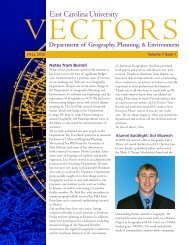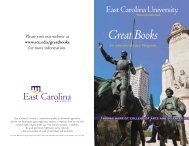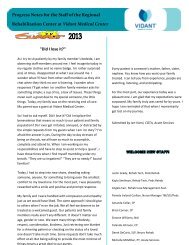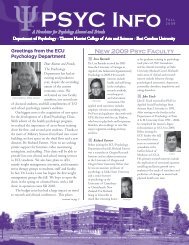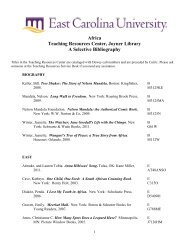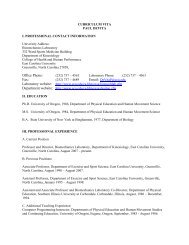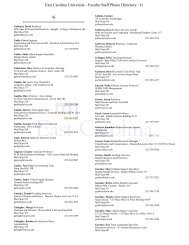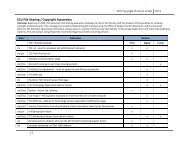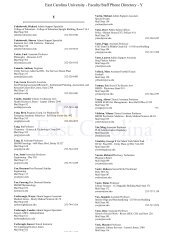Geography News - East Carolina University
Geography News - East Carolina University
Geography News - East Carolina University
You also want an ePaper? Increase the reach of your titles
YUMPU automatically turns print PDFs into web optimized ePapers that Google loves.
FALL 2012<br />
Department of<br />
<strong>Geography</strong> <strong>News</strong><br />
Notes from Burrell<br />
It has been a very busy semester, which helps<br />
to explain this late version of Vectors. The<br />
most time-consuming activity was the external<br />
review. We spent the first part of the semester<br />
perfecting our self-study document. In late<br />
October, we spent 2 ½ days with the reviewers<br />
(Dr. Greg Carbone from the <strong>University</strong> of<br />
South <strong>Carolina</strong>, Dr. Judith Kenney from the<br />
<strong>University</strong> of Wisconsin, Milwaukee, and Dr.<br />
Lester Zeager from the ECU Department of<br />
Economics). They were an excellent group<br />
who asked many probing questions and made<br />
a number of excellent observations. The “word<br />
on the street” from several administrators is<br />
that we came out very well in the eyes of the<br />
reviewers. Thanks to all who responded to<br />
our alumni survey. Those responses were an<br />
important part of the self-study document. We<br />
will be receiving their report any day now, after<br />
which we will develop a response and set out<br />
to implement the recommendations that the<br />
administration and we agree upon.<br />
We had an exciting time with Hurricane<br />
Irene. Fortunately, no one in the department<br />
experienced serious damage to their homes,<br />
though one or two were without electricity for<br />
several days. The university experienced some<br />
damage, but nothing in the department. As<br />
good geographers and planners, however, we<br />
were able to incorporate the event into our<br />
teaching and research. Irene found her way into<br />
atmospheric science classes, the Water Planet,<br />
planning courses, and many more. Talk about an<br />
excellent case study. Dr. Curtis even took some<br />
students in the field to take some measurements<br />
(much to my chagrin!). See page 5.<br />
Volume 5 Issue 1<br />
These two events were probably the biggest of<br />
the semester, but we were kept busy with many<br />
other activities. We had a great colloquium<br />
series and learned about such diverse topics as<br />
immigration policy, West Nile virus, southeast<br />
United States climatology, and environmental<br />
planning. ECU <strong>Geography</strong> was well represented<br />
at SEDAAG and we took home several awards<br />
See pages 3 and 4.<br />
Through this newsletter you will learn all about<br />
what we have been doing. As always, we want<br />
to hear from you! Please keep in touch. Please<br />
come by. We would love to have you visit, meet<br />
with faculty and tour the department.<br />
Dr. Burrell Montz, Chair.<br />
Alumni Spotlight<br />
In the Fall semester of 2006, Suzanne McArdle<br />
arrived in Greenville to begin her Master of Arts<br />
in <strong>Geography</strong> after completing a BS in <strong>Geography</strong><br />
and Geosciences with a concentration in GIS from<br />
Salisbury <strong>University</strong>, Salisbury MD. By the end of<br />
Spring semester 2008 she had completed her thesis,<br />
“Come ‘Out,’ Come ‘Out,’ Wherever You Are: The<br />
MySpace Lesbian and Her Material Social Worlds”<br />
under the direction of Dr. Alderman. Immediately<br />
she returned to Maryland to join the US Census
Inside This Issue<br />
Alumni Spotlight 1<br />
<strong>News</strong> and Events 2<br />
Newest Alums 6<br />
4<br />
Bureau as a cartographer. There she is a member<br />
of a software development team who programs<br />
and maintains the in-house automated mapping<br />
production system which generated millions of<br />
high quality maps to support the 2010 Census<br />
field operations. Suzanne and the rest of this team<br />
were recognized by Director Robert Groves with<br />
the 2010 US Census Bureau Director’s Award for<br />
Innovation for creating an innovative high-volume,<br />
parameter-driven, artificial intelligence technical<br />
solution for optimizing map design and production<br />
which resulted in substantial savings of time and<br />
resources.<br />
She also works on a small team that developed<br />
and maintains an automated generalization system<br />
which takes advantage of the Oracle Spatial<br />
topology model to hierarchically generalize<br />
boundaries from the <strong>Geography</strong> Division’s TIGER<br />
spatial database. Generalized cartographic<br />
boundary files are created to support small scale<br />
mapping endeavors within the agency such as<br />
the American Fact Finder, in addition some<br />
generalized boundaries are being released to the<br />
public. Suzanne authors the FGDC metadata that<br />
accompanies a number of the publicly released<br />
products. She is also responsible for creating<br />
quality assurance procedures and documentation<br />
for cartographic product creation.<br />
“I am extremely grateful for the opportunities I<br />
had and experiences I gained while at ECU. One<br />
of my favorite parts of being at ECU was the<br />
mutual respect between professors and students in<br />
the <strong>Geography</strong> Department. Creative ideas and<br />
research were encouraged, and that certainly kept<br />
me motivated to continue thinking in different<br />
ways and I became aware of many new schools of<br />
geographic thought.The department and GeoClub’s<br />
support of student travel to conferences was key<br />
for gaining exposure to current<br />
trends in geographic research,<br />
developing confidence in my<br />
communication skills whether<br />
it was presenting or networking,<br />
and above all, it allowed me<br />
to see firsthand that not all<br />
geography programs are created<br />
equal. I attribute finding a great<br />
career right after school to the<br />
people, knowledge and skills I<br />
got to know in Brewster.”<br />
Department<br />
<strong>News</strong> and Events<br />
Urban Regional Planning Update<br />
By Jerry Weitz, Director<br />
This fall the planning faculty has been busy<br />
working on changes to the curriculum for the<br />
Bachelor of Science in Urban and Regional<br />
Planning degree. The most complex of these<br />
is a complete revamp of the options for<br />
concentrations. Planning majors may choose a<br />
minor or two concentrations in lieu of a minor.<br />
We developed a revised set of concentration areas<br />
that, if approved, will make our graduates more<br />
competitive.<br />
Meanwhile, work also continues on our pursuit<br />
of a Master of Community Planning degree<br />
program. It will be only the second in the entire<br />
state. There is strong demand for our proposed<br />
graduate planning program.<br />
Although set back some by budget cuts, the<br />
loss of the fixed-term faculty position held by<br />
Al Burne and Al’s fight with health issues, we<br />
are greatly relieved and thankful to hear of his<br />
miraculous recovery. He will return to teaching<br />
duties part-time in Spring 2012. Welcome back,<br />
Al! We also welcome back Deanna Swain in<br />
Spring 2012 as an adjunct faculty.<br />
Speaking of faculty, there is a trend toward<br />
integrating more field-based learning<br />
opportunities in our planning courses. In Dr.<br />
Dan Marcucci’s classes this fall semester, students<br />
went on a canoe expedition to learn about river<br />
ecosystems and took a trip through the Roanoke<br />
River basin to learn about large-scale regional<br />
ecological landscape planning. In Dr. Anuradha<br />
South Mills student planning team from Dr. Weitz’s land use planning class.<br />
Pictured left to right, back row, Nick Snyder, Waller Whittemore, Thomas Shreve,<br />
Chad Buch; front row, Chris Lawson (resident and advisor), Margaux Kerr, Dylan<br />
McDonnell and John Burleson.
Mukherji’s urban<br />
design class, a<br />
field trip gave<br />
students firsthand<br />
knowledge<br />
of urban design<br />
issues. In the<br />
spring Dr. Misun<br />
Hur is planning<br />
to replace<br />
much of the<br />
classroom time<br />
with experiential learning for her neighborhood<br />
planning course by taking walking tours of city<br />
neighborhoods. In my land use planning class<br />
this fall, several students visited Camden County,<br />
NC, to experience public participation in action<br />
and translating public sentiments into community<br />
plans.<br />
The planning program’s university service was<br />
led by Dr. Mulatu Wubneh with his recent<br />
completion of a fiscal impact study of ECU on<br />
the community. The cover is seen above. Service to<br />
profession has also been led by Dr. Wubneh with<br />
his role in the Association of Collegiate Schools<br />
of Planning (ACSP’s) minorities committee.<br />
The entire planning faculty attended the ACSP<br />
conference in Salt Lake City this October.<br />
Students have been investing energies in their<br />
own organization, Student Planners’ Action<br />
Network (SPAN) as well. We thank the officers<br />
and planning student body for keeping the<br />
organization active, relevant, and fun this year, and<br />
we look forward to finalizing arrangements soon<br />
for our spring 2012 SPAN banquet.<br />
Outreach to communities will continue. Service<br />
projects involving students and planning faculty<br />
have been arranged and completed for the Mid-<br />
<strong>East</strong> Commission, the Town of Hookerton,<br />
Edgecombe County, Camden County, and<br />
Greenville. Dr. Marcucci is in the process of<br />
winding down his multi-year effort on the<br />
environmental impacts of the proposed Mid-<br />
Currituck bridge project. Faculty research<br />
continues in the arenas of neighborhood<br />
planning, evaluation of the implementation<br />
of hazard mitigation plans in coastal North<br />
<strong>Carolina</strong>, and the extent of job sprawl in the<br />
U.S., among others. These and other efforts are<br />
moving the planning program in the direction of<br />
more intensive scholarly research, much-expanded<br />
field-based learning opportunities for students,<br />
and stronger, outreach to communities in <strong>East</strong>ern<br />
North <strong>Carolina</strong>.<br />
Awards and Honors<br />
Every Pirate Needs a Treasure Map<br />
This was the theme of the of the New Student<br />
Convocation and the title of the Keynote Address<br />
given by Dr. Derek Alderman. There were about<br />
3000 students, faculty, and staff in attendance.<br />
Dr. Derek Alderman pictured giving keynote address at the<br />
new student convocation.<br />
National Science Foundation Grant<br />
Dr. Tom Rickenbach and Dr. Rosana Nieto-Ferreira<br />
are the recent recipients of a three-year, $314,000<br />
National Science Foundation grant, funded by the<br />
NSF Directorate for Geosciences’ Atmospheric and<br />
Geospace Sciences Division.<br />
In their grant proposal, “Development of a Climatology of<br />
Precipitation System Organization in North <strong>Carolina</strong> to Improve<br />
Climate Precipitation Forecasts,” Rickenbach and Nieto-<br />
Ferreira suggest that climate change places pressure<br />
on North <strong>Carolina</strong>’s fresh water supply in ways that<br />
are not fully understood. They propose that knowing<br />
how year-to-year changes in the atmosphere control<br />
the way in which precipitation is delivered to the state<br />
will lead to a better understanding of the impact that<br />
these changes have on the current and future climate of<br />
North <strong>Carolina</strong>, directly impacting all residents.<br />
SEDAAG Student Awards<br />
At the 2011 SEDAAG meeting in Savannah, GA,<br />
Michael Griffin, won the Master’s honor paper<br />
competition for Estimating Future Water Resource<br />
Health in the Lower Cape Fear Basin, North <strong>Carolina</strong><br />
and Kelsey Mulder got honorable mention for her<br />
Master’s honor paper, Likelihood of Response to Flash<br />
Flooding: Case Study of Boulder, Colorado.<br />
<strong>Geography</strong>
Students Place in Map ESRI Competion<br />
Working with Dr. Allen, Brent Gore, Matt Carey,<br />
Travis Hill, and Michelle Covi placed in the<br />
2011 ESRI map gallery competition Best Map<br />
Product in a Digital Display Format category<br />
for their map, Sea-Level Rise Vulnerability in the<br />
Albemarle-Pamlico Estuarine System, North <strong>Carolina</strong>.<br />
Honoray coach, Dr. Viva Reynolds, pictuted at lower left, is<br />
on the sidelines with Lady Pirates’ players and coaches for<br />
the 11/17 game with Virginia Intermont.<br />
Reynolds Named Honorary Coach<br />
Each year the ECU women’s basketball players<br />
each get to nominate one ECU professor to be<br />
an Honorary Coach for a game. This year the<br />
team members chose Dr. Viva Reynolds. Viva, her<br />
husband and daughter arrived at Minges Coliseum<br />
and received passes to the game. While her family<br />
found seats on the bleachers, Dr. Reynolds was<br />
allowed into the locker room area where she was<br />
introduced to the team members and coaches and<br />
given a signed team photograph. She even gave a<br />
brief speech, “Go Pirates!”, and then listened to<br />
Coach Macy’s final words of team encouragement<br />
and game plays. For the pre-game team warmups<br />
and introduction as well as during the game<br />
itself, she was allowed to sit on the bench, talk<br />
with the players, observe all of the plays drawn<br />
out by coaches during time outs, and to really feel<br />
part of the team. She reports, “This experience<br />
was a great way for me to show my daughter<br />
great college and professional role models and it<br />
reminded me of how hard our dedicated studentathletes<br />
work while at ECU.”<br />
Alderman Regional Councillor &<br />
2011 Outstanding Service Award<br />
In July of 2011, Dr. Derek Alderman was elected<br />
Regional Councillor for the Southeastern Division<br />
within the Association of American Geographers.<br />
This fall he was recognized by SEDAAG again by<br />
being awarded the 2011 Outstanding Service Award.<br />
It is a region-wide recognition of service to the<br />
organization, the discipline of <strong>Geography</strong>, and the<br />
broader community.<br />
Undergrad Focus<br />
Jamie Wheeler Wins 2011 Undergrad<br />
Research & Creativity Award<br />
This Fall semester, Jamie was awarded an<br />
ECU Undergraduate Research and Creative<br />
Activity Award for her work as a GIS specialist<br />
on research studying the possible impacts of<br />
hydraulic fracturing in North <strong>Carolina</strong>. The<br />
project is a joint effort between the <strong>Geography</strong><br />
and Geology departments at ECU, and includes<br />
Dr. Burrell Montz, Dr. Alex Manda, and Ph.D.<br />
candidate Wendy Klein.<br />
The purpose of the research is to develop a model<br />
to analyze and compare the potential locations<br />
and effects of the hydraulic fracturing method<br />
of drilling for natural gas on water quantity and<br />
quality in North <strong>Carolina</strong> and other states along<br />
the <strong>East</strong>ern Seaboard. Her tasks include: building<br />
a GIS database by reseraching and obtainng<br />
geologic maps, hydrologic data, aquifer locations,<br />
Jamie Wheeler and her daughter are shown here whitewater<br />
rafting in the mountains at Big Creek, TN this past summer.
natural gas distribution lines, transportation<br />
routes, and hydraulic fracturing leases, the<br />
exploration of the spatial relationships among<br />
water resources, distribution lines, shale deposits<br />
and transportation routes, and and the design<br />
and production of cartographic products.<br />
Jamie is a very busy young woman. She has a<br />
fiance named Frank, a 7 year old daughter Kylie,<br />
and a soon to be step-daughter 11 year old<br />
Katelyn. Jamie reports being “honored to receive<br />
the award and excited about participating in this<br />
important project!”<br />
Into Hurricane Irene*<br />
When many people were inside their homes while<br />
Hurricane Irene battered North <strong>Carolina</strong>, one<br />
courageous group from <strong>East</strong> <strong>Carolina</strong> <strong>University</strong><br />
braved the storm. Four students in the combined<br />
Coastal Storms and graduate Advanced Coastal<br />
Storms class led by Dr. Scott Curtis, ventured<br />
out into the elements to document valuable data<br />
about this hurricane.<br />
Curtis and his students traveled mainly around<br />
Pitt County for the duration of the field trip.<br />
Every 20 minutes or so, Curtis stopped their van<br />
and he and his students took measurements of<br />
the wind speed and pressure levels of the storm<br />
with their handheld instruments. They also tried<br />
to measure the rainfall, but because of the intense<br />
winds, the rain gauge was not reading accurately.<br />
Noah Poe, an undergraduate in applied<br />
atmospheric science, and Kelsey Mulder, a<br />
graduate student in geography, went on the<br />
field trip. They both agreed that the trip was a<br />
fantastic experience.<br />
*Excerpted from “Into the Storm”, by Meagan Williford,<br />
ECU <strong>University</strong> Marketing, 9-7-11. Photos by Cliff Hollis,<br />
ECU <strong>News</strong> Services.<br />
Graduate student Kelsey Mulder using a Kestral handheld<br />
instrument which measures wind speed and surface pressure.<br />
Cliff Hollis, ECU <strong>News</strong> Services.<br />
Undergraduate student Noah Poe using a Kestral handheld<br />
instrument which measures wind speed and surface pressure.<br />
Cliff Hollis, ECU <strong>News</strong> Services.<br />
Busy Fall for GeoClub<br />
The school year started off with a rumble and<br />
a bang with an uncharacteristic <strong>East</strong> Coast<br />
earthquake and Hurricane Irene. Since then, the<br />
group has met informally at Winslow’s trivia<br />
night every Sunday and has placed in the top<br />
three nearly every week, especially with the help<br />
of geography related questions and trial run at<br />
GeoBowl early in the semester.<br />
Most recently, many GeoClub members attended<br />
the annual Southeast Division of the Association<br />
of American Geographers (SEDAAG) meeting<br />
in Savannah, GA. Funding for the trip was<br />
provided through the ECU Student Government<br />
Association and covered hotel expenses. Members<br />
had the opportunity to hear relevant research,<br />
network with other schools, and some students<br />
presented their work. It has been a busy and<br />
fulfilling semester so far. For the rest of the year,<br />
the American Meteorological Society and AAG<br />
conferences are on the docket as are making club<br />
shirts and a bowling night or two.<br />
Spotted outside Brewster Building on a balmy November day<br />
the undergraduate students seen below are working on final<br />
course projects in GEOG4510 Meteorological Instruments and<br />
Observations. The projects are to compare wind measurements<br />
between sonic anemometer and propeller anemometer for<br />
one student, Jason Blumenfeld, BS Applied <strong>Geography</strong> major,<br />
and to examine wind change with height using two sonic<br />
anemometers for Mark Nissenbaum, BS AAS major. The<br />
other student, John Benedic was helping with the setup.
Our Newest Alums<br />
Summer & Fall 2011 Undergraduates<br />
Seth A. Avrette, BS Urban & Regional Planning<br />
Donisha S. Brown, BS Urban & Regional Planning<br />
Shiloh P. Canale, BA <strong>Geography</strong><br />
Charles M. Chappell, BS Urban & Regional Planning<br />
Christopher T. Ford, BS Urban & Regional Planning<br />
Noah H. Gillam, BS Urban & Regional Planning<br />
Curtis R. Hoffman, BS Urban & Regional Planning<br />
Olajuwon D. Lyles, BS Urban & Regional Planning<br />
Steven R. Mattocks, BS Applied <strong>Geography</strong>, Certificate<br />
in Geographic Information Systems.<br />
Cory E. Mullen, BS Applied <strong>Geography</strong><br />
Justine A. Rountree, BS Applied <strong>Geography</strong><br />
Amy N. Shew, BS <strong>Geography</strong>, Certificate in Geographic<br />
Information Systems<br />
Zachary A. Smith, BS Applied <strong>Geography</strong><br />
Nicholas R. Snyder, BS Urban & Regional Planning<br />
Wyatt R. Thorpe, BA <strong>Geography</strong><br />
Chelsea A. Weiner, BS Urban & Regional Planning<br />
Joshua K. Whaley, BS <strong>Geography</strong>, Certificate in<br />
Geographic Information Systems.<br />
Alice L. Wilson, BS Urban & Regional Planning<br />
Geo Challenge<br />
How many current students and faulty members<br />
can you recogize in the Terrestrial Laser scan<br />
below? A version will be available on the Facebook<br />
Alumni page. Tag as many as you can! Search for<br />
ECU <strong>Geography</strong> Alumni. If you have photos or<br />
anecdotes please share them on the Alumni page.<br />
Summer & Fall 2011 Master of Arts<br />
Bryce Carmichael, A Validation assessment of<br />
the Hazards of Place Model of Vulnerability for<br />
Northeastern North <strong>Carolina</strong>.<br />
Richard Curran. The Utility of Digital Globe’s<br />
Worldview-2 Satellite Data in Mapping Seagrass in<br />
North <strong>Carolina</strong> Estuaries.<br />
James Edwards, Prioritization of <strong>Carolina</strong> Bats as<br />
Mitigation Projects From a Herpetofaunal Perspective.<br />
Laurynas Gedminas, Evaluating Hurricane<br />
Advisories Using Eye-tracking and Biometric Data.<br />
Michael Griffin, Assessing Future Water Resources: The<br />
Influence of Climate Change, Population Growth and Land<br />
Use change in the Lower Cape Fear Basi, North <strong>Carolina</strong>.<br />
Allison Hueber, Analyzing Resident Place Satisfaction<br />
in a Tourist Destination through Auto Photography: The<br />
Case of Southern Shores, NC.<br />
Gary Monitz, Using Vulnerability and Planning Data<br />
to Measure Resilience in Coastal North <strong>Carolina</strong>.<br />
Sarah Jessop, Mid-Summer Dry Spell and Agriculture<br />
in Jamaica: Implimcations For Farming Practices,<br />
Techniques, and Culture.<br />
What’s Up With You?<br />
Do you have news to share with your fellow<br />
Department of <strong>Geography</strong> alumni? How about<br />
an idea you think would make a good story for<br />
Vectors? Email Karen at mulcahyk@ecu.edu or<br />
post it on Facebook.<br />
Students and faculty pose for a high resolution terrestrial laser scan of themselves to be used on GeoClub t-shirts.



